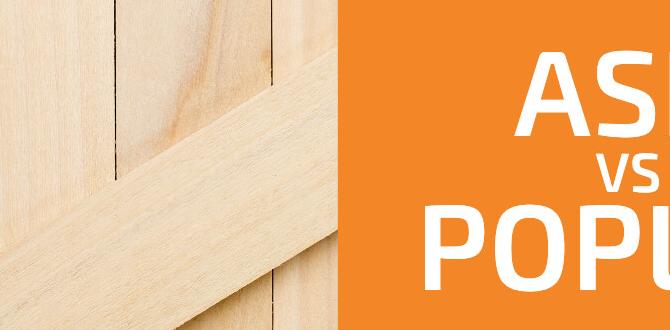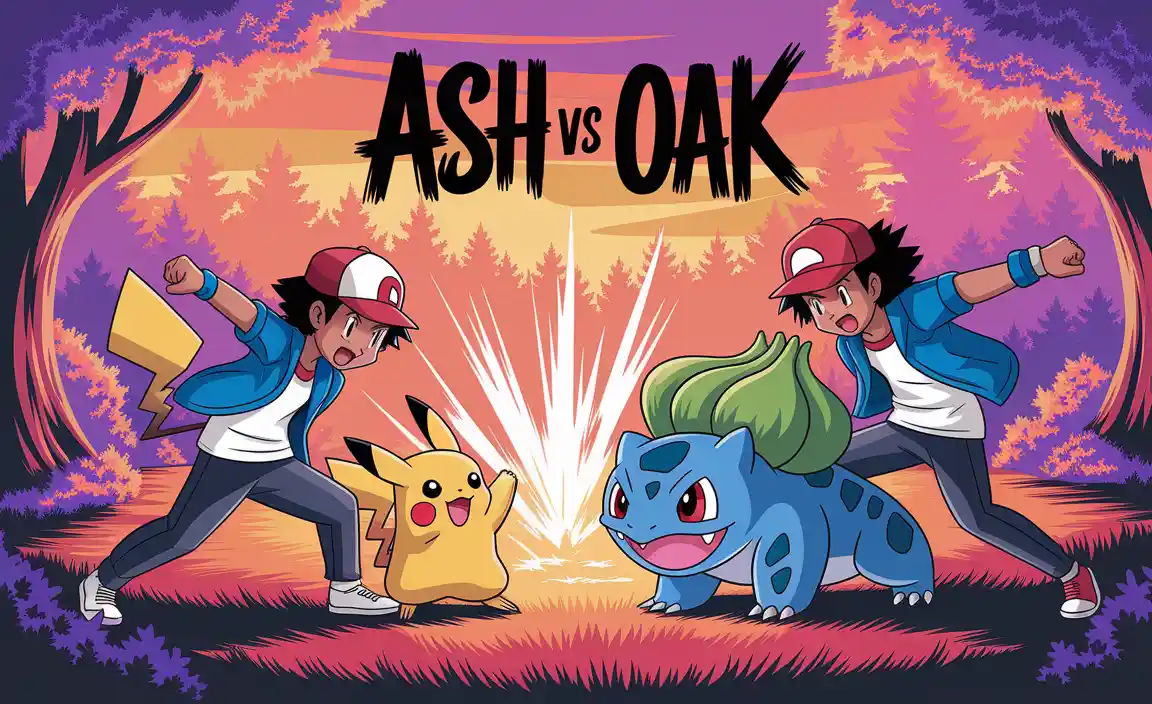Have you ever wondered about the differences between poplar and ash wood? Both trees are popular choices for many projects, but they each have unique qualities. Imagine building a treehouse or crafting a beautiful piece of furniture. Which wood would you choose?
Poplar wood is known for being soft and easy to work with. It often comes at a lower cost, making it great for beginners. On the other hand, ash wood is strong and can handle heavy use, perfect for sports equipment or sturdy cabinets.
Did you know that ash wood has a striking grain pattern? It can bring a special touch to any design. In this article, we’ll explore more fun facts and details about poplar vs ash. You’ll discover which wood might be the best fit for your next project!
Table of Contents
Poplar Vs Ash: Comparing Two Versatile Timber Species

Poplar Vs Ash
When choosing wood, poplar and ash have unique traits. Poplar is often lighter, making it easier to work with, while ash offers strength and durability. Did you know that ash wood is perfect for making baseball bats due to its resilience? Poplar has a smooth finish, ideal for painting. Each wood type suits different projects. So, what’s your next DIY idea? With this knowledge, you can pick the best wood for your needs.Characteristics of Poplar Wood
Description of color, grain, and texture. Common uses and applications in woodworking.Poplar wood is like the cool kid in the lumber yard! Its light color often varies from creamy white to pale yellow. The grain is usually straight and can show a subtle sheen. This wood is famous for being easy to work with, making it great for furniture and cabinets. People love using it for models and toys too. Plus, it’s lightweight, which means you won’t need a gym membership to carry it around!
| Characteristic | Description |
|---|---|
| Color | Creamy white to pale yellow |
| Grain | Straight with a subtle sheen |
| Common Uses | Furniture, cabinets, models, toys |
Characteristics of Ash Wood
Description of color, grain, and texture. Common uses and applications in woodworking.Ash wood has a light to medium brown color. Sometimes it can have a hint of gray or yellow. The grain is straight, which gives it a neat look. The texture is smooth, making it easy to work with. Ash is popular for many uses, like:
- Furniture: Chairs and tables are often made from ash.
- Flooring: This wood is strong and looks great for floors.
- Sports equipment: It’s used for baseball bats and other gear.
Overall, ash wood is a favorite among woodworkers for its beauty and strength.
What are the main characteristics of ash wood?
The main characteristics of ash wood include its strength and durability. It is also known for good shock resistance. Its light color and attractive grain make it a favorite in both everyday furniture and special projects.
Durability and Strength Comparison
Analyzing the hardness and strength values. Resistance to wear and tear.When we talk about strength, Poplar and Ash stand side by side like two sturdy trees in a forest. Ash wood is known to flex under pressure without breaking. It scores **1,200** on the Janka hardness scale, making it quite tough. Meanwhile, Poplar isn’t a featherweight, but it doesn’t quite measure up, scoring around **540**. This means Ash is better at resisting wear and tear over time. Think of it as Ash being the superhero of the wood world while Poplar is more of the friendly sidekick!
| Wood Type | Janka Hardness Score | Durability |
|---|---|---|
| Ash | 1,200 | High |
| Poplar | 540 | Medium |
Workability of Poplar and Ash
Ease of cutting, shaping, and finishing. Factors affecting workability in woodworking projects.Woodworkers care about how easy it is to shape wood. Poplar is known for its softness, making it easy to cut and shape. Ash, however, is tougher but can still be worked with patience. Key points to consider for workability include:
- Grain Direction: This affects cutting ease.
- Moisture Content: Wet wood is harder to work.
- Tool Sharpness: Sharp tools make a smoother finish.
Good tools and careful choices can make both woods enjoyable to work with.
Which wood is easier to work with?
Poplar is generally easier to work with than ash. Its soft texture allows for easier cutting and shaping, making it great for beginners.
Cultural and Historical Significance
Historical uses of Poplar and Ash in craftsmanship. Cultural significance in different regions.Wood from poplar and ash trees has played a key role in craftsmanship throughout history. Many artists and builders crafted homes and furniture using these woods. In different cultures, these trees hold special meaning. For example:
- Poplar is valued in Europe for making musical instruments.
- Ash is a favorite in Scandinavia for carving and tool making.
- Both trees symbolize strength and resilience across various regions.
Each culture has stories and traditions tied to these trees, highlighting their importance in daily life.
What are the historical uses of Poplar and Ash?
Poplar was often used for furniture and paper, while ash was favored for sturdy tools and sports equipment.
Price and Availability
Market trends: cost comparison of Poplar vs Ash. Availability and sourcing considerations.Prices for Poplar and Ash wood can vary greatly. Poplar is generally cheaper than Ash. This makes Poplar a popular choice for many projects. Ash, while more expensive, offers greater durability. Availability also matters. Poplar is easier to find in stores due to its popularity. Ash might require more effort to source, especially in certain regions.
- Cost: Poplar is more affordable.
- Durability: Ash is stronger and lasts longer.
- Availability: Poplar is widely available.
- Sourcing: Ash may be harder to find.
How do Poplar and Ash compare in price?
In general, Poplar is cheaper than Ash. This trend helps many buyers choose Poplar for various projects.
What affects the availability of Poplar and Ash?
The demand for each type of wood can impact availability. Poplar is often in higher supply, making it easier to find.
Environmental Impact and Sustainability
Ecofriendliness of production and sourcing. Certification and responsible forestry practices.Choosing the right wood is important for our planet. Poplar and Ash are both good choices, but they come from different sources. It’s key to look for wood that is grown responsibly. Sustainable practices help keep forests safe. Here are some ways to tell if wood is eco-friendly:
- Look for certifications like FSC (Forest Stewardship Council).
- Check if the wood is sourced from managed forests.
- Support companies that use renewable resources.
Doing this helps protect trees and wildlife. Simple choices can have a big impact!
What are the certification standards for wood?
Many wood products come with labels that show their eco-friendliness. FSC is one such label. It means the wood is from well-managed forests. Always look for these certifications when buying.
Best Projects for Poplar and Ash
Recommended woodworking projects suited for each type. Pros and cons of using each wood type in these projects.Poplar and ash each have their strengths for woodworking. Projects shine with the right wood. For poplar, consider toys and furniture. It is light and easy to paint, but soft, so be gentle! Ash works well for cabinets and flooring. It is strong and durable but can be more difficult to work with. Here are quick pros and cons:
- Poplar: Pros: Lightweight, easy to paint. Cons: Soft, less durable.
- Ash: Pros: Strong, good for heavy projects. Cons: Hard to shape, can be pricier.
What projects can you use poplar or ash for?
Many projects are great for these woods. For poplar, you can build toys. Ash is perfect for furniture choices. Choose the right wood for success!
Conclusion
In summary, poplar and ash both have unique qualities. Poplar is lightweight and easy to work with, ideal for furniture. Ash is strong and flexible, great for tools and sports equipment. You should consider your project needs when choosing between them. Explore more about these woods to see which one fits your next crafting adventure best!FAQs
What Are The Main Differences In Physical Properties Between Poplar And Ash Wood?Poplar wood is lighter and softer than ash wood. This means that poplar is easier to cut and shape. Ash wood is stronger and more durable, making it great for heavy furniture. Also, poplar usually has a light color, while ash can be darker and has more grain patterns. So, if you need something strong, choose ash; for lighter projects, go with poplar!
How Do The Durability And Weather Resistance Of Poplar Compare To That Of Ash?Poplar wood is not as strong or weather-resistant as ash wood. Ash can handle tough weather and last longer outside. If you want wood for outdoor use, ash is a better choice. Poplar is best for indoor projects because it doesn’t resist the weather well. So, choose carefully based on where you plan to use the wood!
In Which Applications Is Poplar Wood Typically Preferred Over Ash, And Why?Poplar wood is often used for making furniture, cabinets, and toys. We prefer poplar because it is lighter and cheaper than ash. It also has a smooth surface, which makes it easy to paint. Ash is stronger, but poplar works better for these everyday items.
How Do The Environmental Impacts Of Harvesting Poplar And Ash Differ?When we cut down poplar trees, they grow back quickly. This helps keep the forest healthy. But when we take away ash trees, it can harm the environment more. Ash trees don’t regrow as fast, and losing them can affect animals and plants living nearby. So, harvesting poplar is better for the environment than harvesting ash.
What Are The Typical Costs Associated With Purchasing Poplar Versus Ash For Woodworking Projects?Poplar wood usually costs less than ash wood. You might pay around $2 to $5 per board foot for poplar. For ash, you could pay between $5 and $10 per board foot. So, poplar is a better choice if you want to save money. Both woods are great for different projects!


